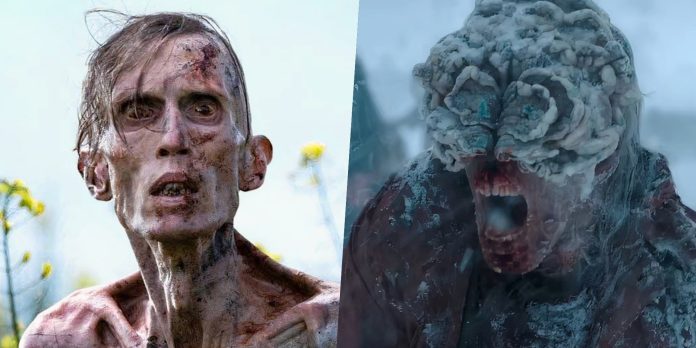In early 2025, an “elevated” story and franchise about a zombie apocalypse came back after years of waiting, years of fans of the original chapter chomping at the bit, and massive hype over what its award-winning creators would come up with next. But now that “The Last of Us” Season Two has finally aired, the arguments over it have barely died down, and its Emmy campaign has only just begun, it is fitting that another elevated franchise about a zombie apocalypse is coming back next after years of waiting. Moreover, the franchise launched 21st-century zombie stories like “The Last of Us” in the first place.
Twenty-three years after Danny Boyle and Alex Garland first explored what happened in “28 Days Later” after a zombie takeover of Britain, “28 Years Later” is their return to the franchise and their relaunch/reboot of it into an entirely new story. Not only does it arrive in the same time frame as the return of “The Last of Us,” but it also has a few other similarities and upcoming obstacles.
Of course, “The Last of Us” is a TV show adapted from a video game instead of a movie franchise based on Boyle and Garland’s then-original idea to revamp the zombie genre. Yet both “The Last of Us” Season One and the original “28 Days Later” were hailed as the crown jewels of the zombie genre in the 21st century, even above many other imitators on movies and television.
Arguably, “The Last of Us” would have never existed in any form if “28 Days Later” hadn’t come about decades ago. Without the viciously fast “rage virus” zombies that replaced the traditional slow-moving zombies of the 20th century, maybe the clickers, bloaters, and other iconic “The Last of Us” monsters wouldn’t have been the next stage in zombie evolution. And maybe if people like Boyle and Garland didn’t make a zombie movie so credible with both critics and audiences, the likes of HBO, Craig Mazin, and Neil Druckmann wouldn’t have taken the next steps to make “The Last of Us” a prestige TV show and Emmy winner.
“The Last of Us” left such a legacy after two video games and one TV season; it made Season Two one of the most anticipated events of early 2025. Likewise, “28 Days Later” left such a legacy with one film from Boyle and Garland – plus a sequel without them in “28 Weeks Later” – it made their return in “28 Years Later” one of the most anticipated films of the summer. Yet considering what the return of “The Last of Us” brought in early 2025, it could be a cautionary tale of sorts for “28 Years Later” mere months later.
The shadow of “The Last of Us” Season One proved to be too overcast for the most frustrated viewers of “The Last of Us” Season Two, whether they knew the controversial twists and story structures from the original game or not. After a long two years of waiting to see how “The Last of Us: Part II” the video game would be handled by HBO, not everyone was happy with the results. Although considering the source material and its own backlash, perhaps they were never going to be. Now, after 23 years of waiting for Boyle and Garland to return to the “28 Days Later” franchise, will the shadow of their original success be too much for “28 Years Later” to live up to as well?
One big difference is that unlike “The Last of Us” Season Two, “28 Years Later” isn’t based on pre-existing source material, so there is nothing beyond the trailers to spoil what’s coming. However, one significant similarity is that, like “The Last of Us” Season Two, “28 Years Later” is only part one of what might be a three-part story when all is said and done.
“The Last of Us: Part II” was such a gigantic video game, it was always going to take two seasons and maybe a maximum of three to adapt it all – as proved by the cliffhanger for “The Last of Us” Season Two and the confirmation of what and who “The Last of Us” Season Three will be about. In a way, “28 Years Later” is working the same way, as it is only meant to be the opening chapter of its new story’s trilogy. Like “The Last of Us,” it already has a second part confirmed, which is set to star a mere supporting character from the first. Like “The Last of Us,” a proposed third part is still not officially green-lit and will depend on future results.
In the case of “28 Years Later,” Nia DaCosta will replace Boyle for the trilogy’s middle chapter, “The Bone Temple,” before Boyle plans to return for the finale. Yet ironically enough, the end of this new “28 Years Later” trilogy is also rumored to do precisely what this “The Last of Us” trilogy won’t – bring back its original lead and breakout human star for the finale. Whereas the return of “The Last of Us” controversially killed off Pedro Pascal’s original lead character at the near beginning, the proposed “28 Years Later” trilogy may well bring back the original “28 Days Later” lead Cillian Murphy to headline its ending if indeed it gets one.
Aside from having zombies, both “The Last of Us” and “28 Days Later” franchises are united in launching leading men who became adored A-listers. Their paths were obviously different, as Murphy became the Oscar-winning headliner of “Oppenheimer” after 20 years of largely supporting roles following “28 Days Later,” while Pascal was already a budding television and film star before “The Last of Us” took his fame to another level. But now, at least in this current moment, Murphy and Pascal are among the most beloved male stars of the last few years, and both have zombie franchises in part to thank for it. Yet one was killed off early by their franchise, and the other may be coming back to theirs if all goes well.
Though Pascal at least helped a whole new story of “The Last of Us” get off the ground before being taken from it, Murphy is another matter for the new story of “28 Years Later.” Like with “The Last of Us” Season Two, “28 Years Later” has a big time jump in its return to a zombie-ravaged world, centers around an isolated community and safe haven, and promptly shatters that safety with the return of the undead. But unlike with “The Last of Us,” there are no original cast members of “28 Days Later” to pick up the torch in “28 Years Later” just yet, as entirely new characters played by the likes of Jodie Comer, Aaron Taylor-Johnson, Ralph Fiennes, Jack O’Connell and more are the new guides this time – before Fiennes headlines “The Bone Temple” sequel and the groundwork is laid for Murphy and Boyle’s return in the finale if Sony ultimately approves it.
With “The Last of Us,” the success of Season One and the backing of HBO made it too big to fail, no matter how much backlash Season Two got. Yet while HBO will surely back a risky Season Three and a possible Season Four if needed no matter what, it may take more convincing box office numbers for Sony to back Boyle and Garland’s entire “28 Years Later” storyline in full. As such, in a way, “28 Years Later” is a bigger gamble for a long-awaited return to a genre-defining zombie story than “The Last of Us” Season Two, even if it has far less divisive and heated twists and turns.
Still, given the buzz in every positive and negative form for “The Last of Us” Season Two, perhaps it creates the ideal climate for another zombie franchise to make a big return of its own. But will the return of Boyle and Garland and the start of a new multi-part story to the “28” legacy go smoother than the briefer return of Pascal and the beginning of a new multi-part story about “The Last of Us” did?
The initial answers about what comes in “28 Years Later” will come on June 20th, before “The Bone Temple” continues the story in early 2026, months, if not a year, or much more before “The Last of Us” Season Three.
Have you seen “28 Years Later” yet? If so, what did you think of it? How did you feel about the first and second seasons of “The Last Of Us?” Please let us know in the comments section below and on Next Best Picture’s X account.
You can follow Robert and hear more of his thoughts on the Oscars & Film on X @Robertdoc1984


